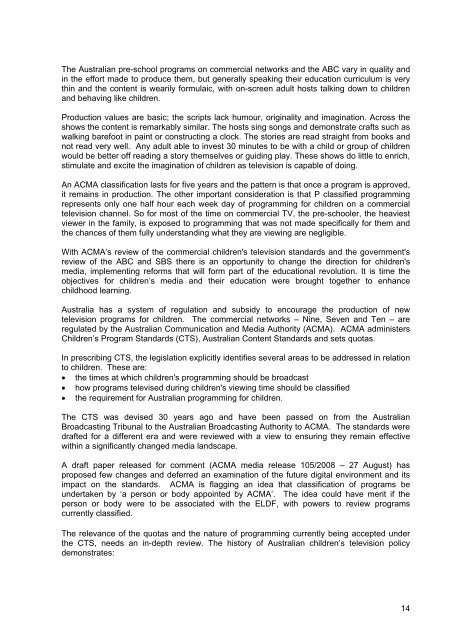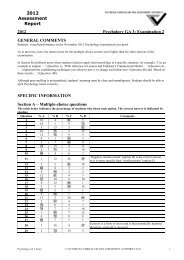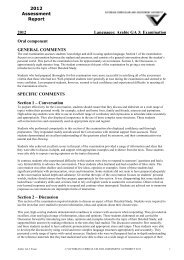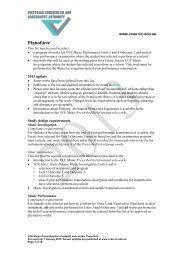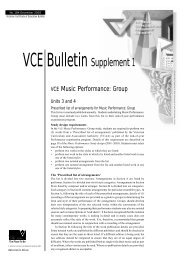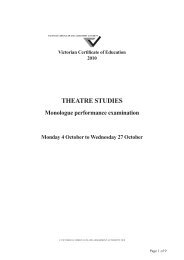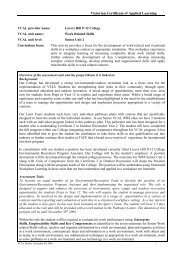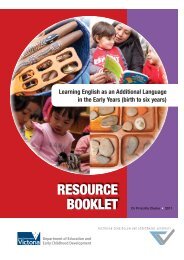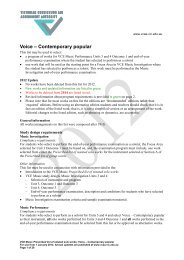television, digital media and children's learning - Victorian ...
television, digital media and children's learning - Victorian ...
television, digital media and children's learning - Victorian ...
You also want an ePaper? Increase the reach of your titles
YUMPU automatically turns print PDFs into web optimized ePapers that Google loves.
The Australian pre-school programs on commercial networks <strong>and</strong> the ABC vary in quality <strong>and</strong><br />
in the effort made to produce them, but generally speaking their education curriculum is very<br />
thin <strong>and</strong> the content is wearily formulaic, with on-screen adult hosts talking down to children<br />
<strong>and</strong> behaving like children.<br />
Production values are basic; the scripts lack humour, originality <strong>and</strong> imagination. Across the<br />
shows the content is remarkably similar. The hosts sing songs <strong>and</strong> demonstrate crafts such as<br />
walking barefoot in paint or constructing a clock. The stories are read straight from books <strong>and</strong><br />
not read very well. Any adult able to invest 30 minutes to be with a child or group of children<br />
would be better off reading a story themselves or guiding play. These shows do little to enrich,<br />
stimulate <strong>and</strong> excite the imagination of children as <strong>television</strong> is capable of doing.<br />
An ACMA classification lasts for five years <strong>and</strong> the pattern is that once a program is approved,<br />
it remains in production. The other important consideration is that P classified programming<br />
represents only one half hour each week day of programming for children on a commercial<br />
<strong>television</strong> channel. So for most of the time on commercial TV, the pre-schooler, the heaviest<br />
viewer in the family, is exposed to programming that was not made specifically for them <strong>and</strong><br />
the chances of them fully underst<strong>and</strong>ing what they are viewing are negligible.<br />
With ACMA’s review of the commercial <strong>children's</strong> <strong>television</strong> st<strong>and</strong>ards <strong>and</strong> the government's<br />
review of the ABC <strong>and</strong> SBS there is an opportunity to change the direction for <strong>children's</strong><br />
<strong>media</strong>, implementing reforms that will form part of the educational revolution. It is time the<br />
objectives for children’s <strong>media</strong> <strong>and</strong> their education were brought together to enhance<br />
childhood <strong>learning</strong>.<br />
Australia has a system of regulation <strong>and</strong> subsidy to encourage the production of new<br />
<strong>television</strong> programs for children. The commercial networks – Nine, Seven <strong>and</strong> Ten – are<br />
regulated by the Australian Communication <strong>and</strong> Media Authority (ACMA). ACMA administers<br />
Children’s Program St<strong>and</strong>ards (CTS), Australian Content St<strong>and</strong>ards <strong>and</strong> sets quotas.<br />
In prescribing CTS, the legislation explicitly identifies several areas to be addressed in relation<br />
to children. These are:<br />
• the times at which <strong>children's</strong> programming should be broadcast<br />
• how programs televised during <strong>children's</strong> viewing time should be classified<br />
• the requirement for Australian programming for children.<br />
The CTS was devised 30 years ago <strong>and</strong> have been passed on from the Australian<br />
Broadcasting Tribunal to the Australian Broadcasting Authority to ACMA. The st<strong>and</strong>ards were<br />
drafted for a different era <strong>and</strong> were reviewed with a view to ensuring they remain effective<br />
within a significantly changed <strong>media</strong> l<strong>and</strong>scape.<br />
A draft paper released for comment (ACMA <strong>media</strong> release 105/2008 – 27 August) has<br />
proposed few changes <strong>and</strong> deferred an examination of the future <strong>digital</strong> environment <strong>and</strong> its<br />
impact on the st<strong>and</strong>ards. ACMA is flagging an idea that classification of programs be<br />
undertaken by ‘a person or body appointed by ACMA’. The idea could have merit if the<br />
person or body were to be associated with the ELDF, with powers to review programs<br />
currently classified.<br />
The relevance of the quotas <strong>and</strong> the nature of programming currently being accepted under<br />
the CTS, needs an in-depth review. The history of Australian children’s <strong>television</strong> policy<br />
demonstrates:<br />
14


